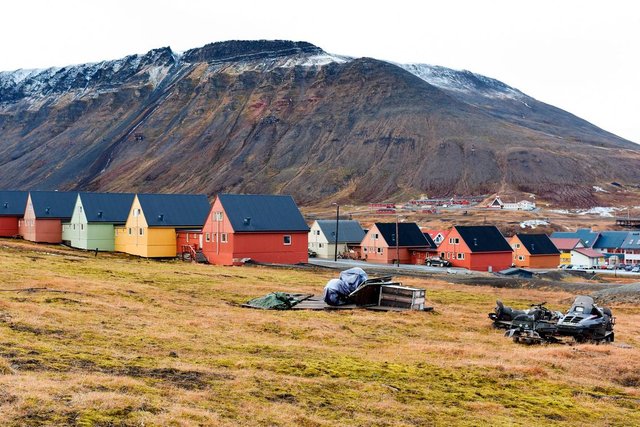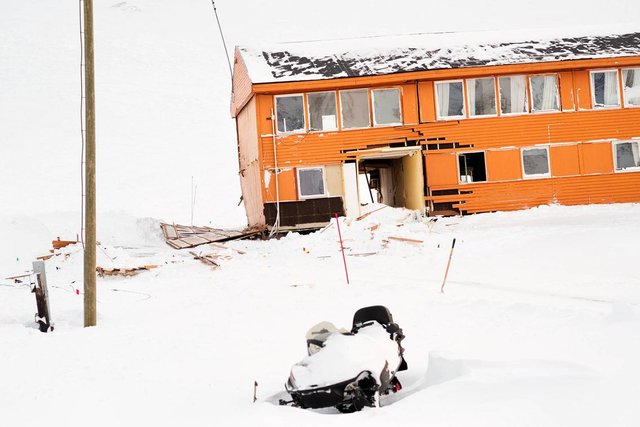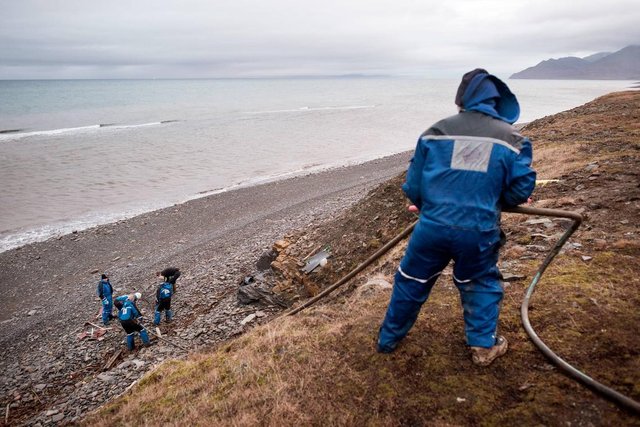Landslides, avalanches and torrential rain. The weather in the Arctic is becoming increasingly extreme.
I'm very interested in weather and climate as a person. Today a newspaper in Sweden, Göteborgs Posten, wrote about the weather and working conditions on the Svalbard Island, the most northern island where people live all the year around. Due to the fact that the weather there change more significantly it's been a very popular place for scientists to gather weather data and visually analyze animal habitats.
I have put some time into translating this article for everyone to read about this very interesting topic. I have translated the article from this source.Enjoy

Landslides, avalanches and torrential rain. The weather in the Arctic is becoming increasingly extreme. On Svalbard, in the world's northernmost society, life has already changed for both humans and animals. GP has followed the scientists who know everything about the soaring temperatures.
Autumn 2016
The field should actually be wrapped in a thick snow cover. Instead, it is dirt brown. Six graduate students and professors are equipped each with a shovel. Some have already begun digging in the rocky beach side. Others help to wear a heavy cable. It rains and blows, but the researchers sweat in their scooter overalls.
"Today it's ten degrees hot outside. It is summer temperatures, not autumn temperatures. This weekend we had heavy snowfall instead of snow. It's not normal, says Frank Nilsen, Professor of Oceanography at the University Center in Svalbard.
Later in the winter,
the soaring temperatures in the Arctic to make headlines in the news media throughout the world, but not just yet. Now researchers shouts to each other in the wind and try to bring order to the muddy cable. Frank Nilsen is the head of the Department of Arctic Geophysics and Expert on Water Temperature and Marine. With the new cable it will be possible to measure the sea temperatures in real time - year round. Before that, the measurements have only taken place on an occasional occasion per year.
"By checking the temperatures we have a look at the climate. Both the seawater and atmospheric temperatures are important, says Frank Nilsen.
Svalbard is located 150 miles north of the polar circle. Here is the world's northernmost airport, the world's northernmost society and the world's northernmost supermarket. Historically, Svalbard has been a mining community, but no longer.
According to the UN climate panel IPCC, the average temperature in the last hundred years has increased twice as fast in the Arctic as in the rest of the world. It has meant that climate scientists from almost all nations chose to settle here. I describe today the scientific community as a beam in the local economy.
Frank Nilsen himself
has looked more closely at the Gulf Stream. It contributes to our relatively comfortable climate in the Nordic region. In Svalbard it has the same effect. Without the Gulf Stream, life would have been a lot of fun and Frank Nilsen could have shown that the Gulf Stream changed direction, closer to the mainland. The hot water prevents the ice from settling down. Open sea absorbs more heat, which further speeds up the warming.The sky is pale pink. It is difficult to determine if we are looking at a sunrise, a sunset or a mix of both. The days are very short and shorter they will be. In seven days the sun sets for the last time. Then, the four-month polar night begins. Only in February will the sun rise again and during the whole dark day there will be no daylight.The cable has to be buried down in time. Otherwise, the work is significantly complicated.
Scientists warn of landslides
The continued rainfall in combination with mild weather has caused the permafrost to thaw. It will not be long before a whole residential area is evacuated in Svalbard's main town Longyearbyen. Landslide risk is judged to be imminent. In mid-November, the Danish weather institute DMI releases a report saying that the temperature in the Arctic is 20 degrees warmer than normal. Such a big deviation also amazes climate scientists and the news is spread all over the world. The Svalbard farmers know that the temperature has been above normal for a total of 76 weeks in a row.
DMI essentially
indicates three explanations. The first is that hot winds are temporarily swept across the area. The other is the weather phenomenon El Niño, which causes warmer weather. The last is the global warming that man has achieved through greenhouse gas emissions.In Svalbard more polar bears live than humans, but the warmer weather causes the glaciers to shrink. Pictures of sickly thin polar bears are spread on the net. At the same time, Donald Trump wins the presidential election in the United States. He is pronounced climate skeptics and is a hot topic in the researchers' break room. How will this affect the climate policy of the world?

Spring 2017
The snow is coming - and with a vengeance. A family is sitting in their apartment and eating breakfast when it begins to rumble from the adjacent mountain with the innocent name Sockertoppen. The avalanche hit straight at the house. Both cars and houses are moved several meters. One short side is broken and the family at breakfast climbs through a window. All do without life-threatening injuries.
Two evenings later,
the village's cinema is filled with about 200 people. The big screen has been rolled away. Instead, there is a long table on the stage. Ready to speak are avalanche experts and politicians. Even the Governor, the Norwegian Government's High Representative on the island, is in place. Some of the residents in the room are upset. Just 14 months earlier, a powerful avalanche occurred in the same residential area. That time, two people died. In connection with this an avalanche warning system, but two hours before the new avalanche went out the authorities assured that the avalanche risk was not imminent. No evacuations needed to be made.
"Nature is erratic, there is no exact science. Our assessment was that the situation was safe. We were wrong", says Governor Kjerstin Askholt.The next day there is a whole shift with miners in work clothes at a cafe in the main street. A new avalanche has buried the highway up to the norwegian mine 7. The miners can not come to work.
One who is twice exposed
is Dan André Danielsen. He can not get to work and he can not go home. Everyone living in the residential area closest to the Sockertoppen is evacuated and may not move back until the avalanche risk is over."But I do not live near the mountain itself. I was actually home when the avalanche went without notice anything. Suddenly the Governor came and began to talk about evacuation. I did not understand anything, says Dan André Danielsen, who now lives temporarily at a colleague's home.
Kim Holmén is international research director and professor of chemical meteorology at the Norwegian polar Institute on Svalbard. He receives us in his office and says that two avalanches that hit Longyearbyen been called hundred-year-avalances. So powerful avalanches will only happen every hundred years, but have now occurred twice in just 14 months.
"I can not say that the avalanches in Svalbard depend on carbon dioxide emissions in Gothenburg, but the more extreme weather is in line with climate research," says Kim Holmén. He is originally from Stockholm, but has lived in Svalbard for 30 years. During that time, he experiences the conditions for both animals and humans greatly.
Svalbard is a unique place
"Here, researchers come from many different countries and research areas to work with the climate. There is a great consensus on what is happening in the Arctic. If you have stood on the glaciers together and see how they have melted, you can not disagree about what's happening, "says Kim Holmén. Previously, the thermometer often showed 30 minus degrees for three consecutive weeks. Now it's as much as 20 minus degrees and the cold weather does not last for as long. Even sea water temperatures are higher.
"When I came here there was a meter of ice on the ice fjord. We drove the scooter straight across. Today the whole fjord is ice-free. Wherever I still look, I see a landscape in a strong change, "says Kim Holmén.
The mild climate
also makes research difficult. For safety reasons, boat bans in the ice fjord are in the winter season. In the past there was no problem. Then the researchers could go scooters on the ice. Now, when the Gulf Stream changes direction and the warmer Atlantic waters come closer to the mainland, the water can not freeze. Without the ice, scientists are stranded. They may not go boating and take the scooter over open ocean is unthinkable.Kim Holmén rises and locks his office space after us. A steep metal staircase leads into a huge logistics warehouse. Here you will find all research equipment used for different expeditions. All research teams have baskets and shelves marked with names and research projects. On a shelf, Kim Holmén reads "ismåke". It is ice gull in English.
"Ismåsen is even more sensitive than the polar bear. The bird is specialized in eating fat. When the polar bear has taken a seal, the ice gull eats the fat and thus has a very high concentration of environmental hazards, "said Kim Holmén.
Beluga and narwhal
has decreased in the area. Both lack dorsal fins and can safely swim under the ice and sleep. The killer whale, whale's greatest enemy, prevented to follow due to its large dorsal fin. But when the sea gets warmer and the ice does not lie, it becomes harder for the whales to find hiding places.Researchers have found that the presence of both the ice gull, polar bear, narwhal and beluga reduced as the ice disappears. Even Spetsbergsgrisslan have it rough. Instead, new species appear in sea and land. Salmon, cod and mackerel, for example.The discoveries are relatively new and the fact is that many research reports from the Arctic have been released in recent years. It's no coincidence.
"We humans have a little hard for cold and dark. This also applies to researchers. During the summer months when it is midnight sun and beautiful, there has been full activity up here. During the dark it has been quiet. This has caused us to get a skew in our data. Winter biology is a relatively new research area. It's only the last five years that we expanded the winter business and gained continuity in research, "said Kim Holmén.
Another who worked hard
to achieve that continuity is Frank Nilsen. After he and his colleagues digged their cable this fall, they have been able to monitor the sea water temperatures hour by hour. The results of the measurements are posted on the university website and the data is available to researchers worldwide.With a few quick clicks, Frank Nilsen gets the charts on his computer screen. In November the sea water temperature was five plus degrees. Now it has fallen to one degree, but it is still remarkably hot.
"During the winter, hot air combined with warm sea water has caused the glaciers to melt quickly. In December, the Tunaglaciäre shrank by three meters a day, says Frank Nilsen.
Climatologists sometimes call the Arctic for the canary bird in the mine. The term is old and originates from a time when the sensitive animals were sent into the mines to detect air pollution. If something was wrong, the canary birds died immediately and the people had a chance to get out before it was too late.
The temperature rise
in the Arctic is record high and what is happening here is expected to happen everywhere - but it happens here first. Frank Nilsen does not see himself as a laboratory animal living in Svalbard. On the contrary, he thrives. "But my wife and I have said that we should move the day that the kids do not want to stay, says Frank Nilsen.Extreme weather, polar bears and winter darkness are just a few of the trials that are exposed to Svalbard. It is also clear that Longyearbyen, located idyllically between several mountains, had never been built in the same place today. With the current conditions, the village had a much safer place in a flat area.
Frank Nilsen states
that isolated weather events in the form of landslides, avalanches and skies are often wiped out as obscene in a broader context, but it's not that easy. "Two weeks of extreme weather conditions can create changes that last for several years. There are probably not many who know", he says.

FACTS: The northernmost society of the world
Svalbard belongs to Norway and Norwegian law applies to the whole group. However, all countries that have signed the so-called Svalbard Treaty have the right to pursue business activities here. On Svalbard, for example, there is a Russian mining town.
Svalbard consists of 60 percent of glaciers, 27 percent unusable rock areas and 13 percent vegetation. On land is therefore sparse life. No tree gets higher than the ankle. However, below the surface is another five. Barents Sea is one of the most diverse seas in the world.
On Svalbard, it is illegal to leave the main city Longyearbyen without a rifle - due to the risk of being attacked by polar bears. For the same reason, it is forbidden to lock the front door. If a polar bear attack there must always be a possibility to escape into the nearest house.
All text in this post originated from this article on GP.se. I have taken my time to translate this to English for everyone to read about this topic. All images belongs to GP.se and/or their author(s)